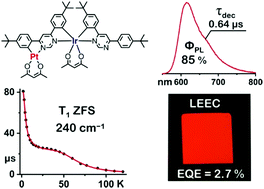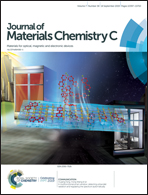An efficient heterodinuclear Ir(iii)/Pt(ii) complex: synthesis, photophysics and application in light-emitting electrochemical cells†
Abstract
We report on the design, synthesis, characterization and successful application of a heterodinuclear Ir(III)/Pt(II) complex endowed with two 4,6-diphenylpyrimidine ligands and two acetylacetonate ligands, with one of the former being the rigid bridging unit between the two metal centers. The heterodinuclear complex exhibits red phosphorescence with a high quantum yield of ΦPL = 85% and a short room-temperature decay time of τ = 640 ns in degassed toluene solution. The high efficiency of the spin-forbidden T1 → S0 transition is demonstrated to originate in a strong spin–orbit coupling of the T1 state with a manifold of excited singlet states, which contributes to the record-breaking zero-field splitting of the T1 state of 240 cm−1. The high-solubility and non-ionic hetero-dinuclear complex was employed as the emissive guest compound in host–guest light-emitting electrochemical cells, and such optimized devices delivered vibrant red emission (λpeak = 615 nm) with a second-fast turn-on and a high external quantum efficiency of 2.7% at a luminance of 265 cd m−2.



 Please wait while we load your content...
Please wait while we load your content...